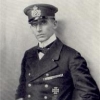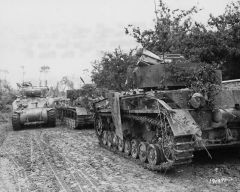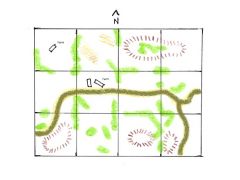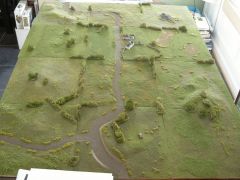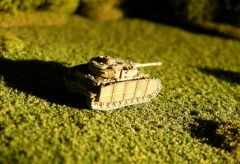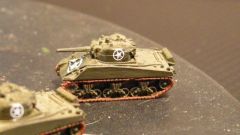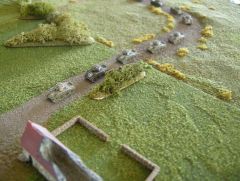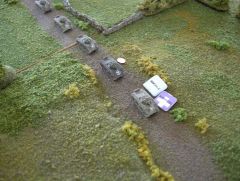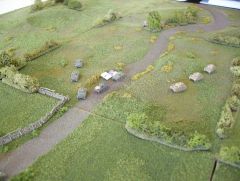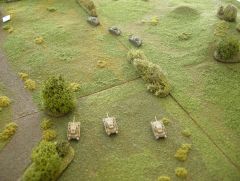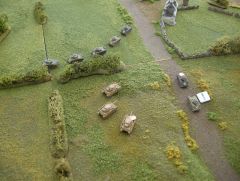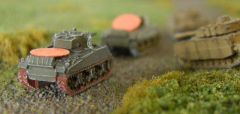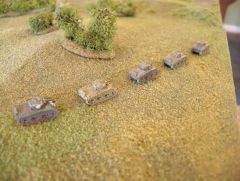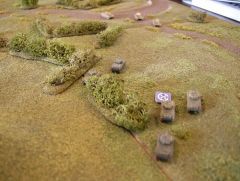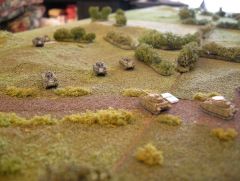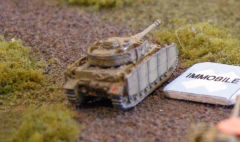AAR - Pt. 2
Turn 6 begins with German initiative. Platoon White is up first. Szelinski orders fire onto the group of Shermans moving left to right in front of him as they try to reach a row of trees at the foot of the hill. The blast of his tank's L48 crashes in his ears and he observes a hit on the second M4 in the group. It lurches to a stop, a faint wisp of smoke trailing from its engine vents. Tank 112 fires at the tank immediately behind but misses overhead. Similarly tank 113 fires at the same trailing M4 and also misses.
Brock's platoon continues moving east across the German front. The crew of the tank Szelinski hit, stopped with unknown damage, recovers and stays with the vehicle. They hear the crash of an American 75mm behind them which hits the German tank 113, penetrating the brake-cooling air intake in front of the driver's position and destroying the vehicle. Meanwhile tank 1, immobilized on the road but still fighting, fires at Panzer 212 at near point-blank range hitting it yet no damage is incurred.
Gullmann's MkIV's push through the smoke past two knocked out Shermans.
Tank 212 returns fire, hitting the immobilized M4 in the hull below the turret blowing it apart in spectacular fashion. Gullmann then orders his tanks down the road back toward the crossroad.
Middlebrook, having consulted his map for an alternate route, orders his tanks south around a small hill where he then plans to make a push east.
Middlebrook's platoon of M4's skirts a low hill and the table-edge motoring southeast toward the crossroad.
Turn 7 and the Germans maintain the initiative. With Brock's remaining M4's moving behind a hedgerow, Szelinski has his two remaining tanks back into a better firing position where he hopes to take the Americans from the flank when they emerge from the tree-line.
The remaining two mobile tanks of Brock's platoon stop momentarily for their commanders to caucus...they decide to improvise and use the tree-line to begin moving onto a steep hill to their left. From there they hope to locate the German tanks that have been pounding them and perhaps make amends.
Gullmann's platoon of Mk IV's continue down the road, expecting Sherman's to burst through the trees at any moment. None are seen and the crossroads is just a short distance ahead.
Middlebrook gets his platoon around the base of the small hill quickly turning east.
Turn 8 and the initiative now shifts to the Americans. The immobilized Sherman of Brock's platoon which has been sitting quiet for some time suddenly fires and hits Szelinski's MkIV. The 75mm round passes through the schurzen to hit the intercooler, spewing hot oil into the engine compartment and filling the tank with smoke. Szelinski orders the turret and driver's hatches thrown open to ventilate the vehicle (they are suppressed, lol). The other two M4's of Brock's platoon continue to move toward the hilltop.
Gullmann's platoon reaches the crossroad and positions his tanks to block Middlebrook's approach from the west.
Turn 9 and the Americans maintain the initiative. The lead tank in Middlebrook's platoon, having swung around a small rise the previous turn, gets off a head-on shot at Gullmann's MkIV and knocks him out. Gullmann and his crew abandon the smoking wreck and run for cover along the edge of the road. Over his shoulder he can see a number of other Shermans moving into view.
Middlebrook's tanks burst through the trees and begin exchanging fire with Gullmann's MkIV's occupying the crossroad.The marker in the foreground is incorrect - it should indicate 'suppressed', not 'casualty'.
Tank 212 of Gullmann's platoon returns fire and hits the lead Sherman (the one which had just knocked out Gullmann) and temporarily stops (suppresses) it. Tank 213's LOS is blocked by a few trees and has no shot at the oncoming M4's.
The last remaining Shermans of Brock's platoon have reached the top of the hill where they take cover behind some trees. Dismounted, the sergeant now commanding can see the Germans below while observing that the distance to the table's edge is not reachable in the final turn. They decide to stop here.
Szelinski, covered in oily soot from the near catastrophic engine-compartment damage, rallies his crew and waits for the Shermans to reappear. Tank 112 remains behind some tree cover on his left.
Turn 10, final turn. The Americans once again have the initiative. Middlebrook, his M4's firing before moving, push toward the crossroad and Gullmann's last two tanks. Spotting a MkIV slightly to his left (212) he orders his gunner to fire, striking the tank's leading armored facia adjacent to the driver's position destroying the gear-box. Immobilized, the tanks commander assessed the situation and orders his crew to continue their shooting. The Sherman on Middlebrook's right fires at the same tank but misses. From behind him, Middlebrook hears tanks 2 and 3 moving up.
Middlebrook (center M4) rolls up to the crossroad moments before being knocked out by a PzkpfwIVH out of the picture on the right. The high-water mark for the Americans.
Tank 212 rallies while 213 fires at Middlebrook's Sherman, hitting the front of the hull, smashing the driver-position and killing his driver before plowing through one of the ammo racks. With the tank filling with smoke and having little faith in the Sherman's wet stowage, Middlebrook orders the crew to bail out.
Szelinski and his two remaining tanks await the last of the Americans to come into view, but they never do.
Results
The Germans knocked out four Shermans for 8 points, while the Americans knocked out two of the six German tanks and immobilized a third for a total of 2 points. They failed to exit any of their tanks off the eastern table-edge. Points aside, the Germans have won a substantial victory as they have stopped/slowed the American advance presumably allowing the less-mobile bits of 9th Panzer Division to slip across the Ure to fight another day.
The American player attempted to quickly move past/around the Germans with limited success, while the relatively narrow field of play greatly helped the Germans block a direct line of advance. In hindsight it can be seen that it would take the Americans nearly five turns to just motor unopposed across the table using road movement...scarcely enough time to deal with a determined adversary. While it came down to the last turn, the scenario could probably stand to be extended a further two turns. A good strategy for the Americans might be to send one platoon straight into the teeth of the German defense while attempting to circumnavigate them with the other (and get off the table, or at least into a position where a last turn dash could be attempted).
The M4A3 with its short 75mm was at a decided disadvantage here. The German 75mm L/48 was clearly superior, with a slight tip to the German crews as well. Certainly the 75mm M4A3 was reaching the end of its usefulness by this point of the war, many of the new M4's having been upgraded to a superior short 76mm.
Observations
MP-Basic is a good, fun game in a beer-and-pretzels sort of way. It is fairly simple, fast moving, highly playable and thankfully doesn't require a bucket of dice to generate results. Calculating to-hit and any resulting abstract damage is simple and quick. To add some interest we used an old damage table from the ancient Angriff! rule-set to put some color on the MP-Basic hit results. It served no purpose other than to further detail the results and perhaps add to the AAR notes. Best of all MP plays quickly...we knocked the whole thing out in a bit more than two hours, pretty good for a first run-through.
Looking forward to incrementally adding the advanced rules and especially getting some infantry on the table.
Immobilized, tank 212 continues pouring fire into the line of advancing Shermans on turn 10. Panzer 212 was the 'ace' of the day with two kills and numerous hits scored. With the tank-recovery teams far to the rear tank 212 will most likely be abandoned and its crew will catch a ride on one of the surviving MkIV's.
Healey



